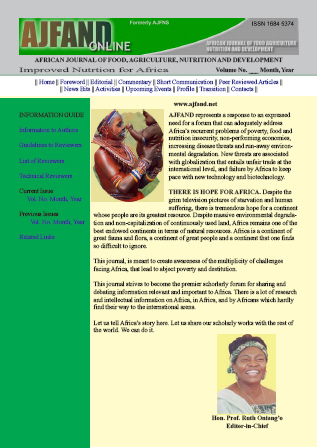
|
African Journal of Food, Agriculture, Nutrition and Development
Rural Outreach Program
ISSN: 1684-5358
EISSN: 1684-5358
Vol. 17, No. 2, 2017, pp. 12130-12141
|
 Bioline Code: nd17045
Bioline Code: nd17045
Full paper language: English
Document type: Research Article
Document available free of charge
|
|
|
African Journal of Food, Agriculture, Nutrition and Development, Vol. 17, No. 2, 2017, pp. 12130-12141
| en |
CHAPTER 17
THE WAY FORWARD
Bouis, H.E.; Saltzman, A.; Low, J.; Ball, A. & Covic, N.
Abstract
Biofortification has made more rapid progress in Africa than in Asia or Latin America.
Thus, Africa provides an important first view into learning how to implement
biofortification successfully, and its potential to improve nutrition and public health. The
preceding articles have summarized the evidence available for biofortification,
particularly in the African context. Over the last 15 years, biofortification research
demonstrated broadly that:
• Conventional breeding can add extra nutrients in the crops without reducing
yields.
• When consumed, the increase in nutrient levels can make a measurable and
significant impact on human nutrition.
• Farmers are willing to grow biofortified crops and consumers to eat them.
While there remains more to be learned, the biofortification intervention should now be
scaled up. To reach full potential, a global effort, with many partners – governments,
researchers, private sector actors, civil society organizations, and farmers – is now
required to bring more crops to more farmers, changing more lives.
Keywords
Biofortification; Micronutrient Deficiency; Agriculture; Nutrition; Micronutrient Targets; HarvestPlus
|
| |
© Copyright 2017 - African Journal of Food, Agriculture, Nutrition and Development
Alternative site location: http://www.ajfand.net/
|
|
